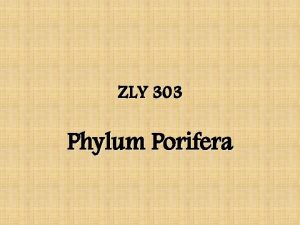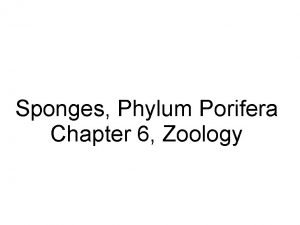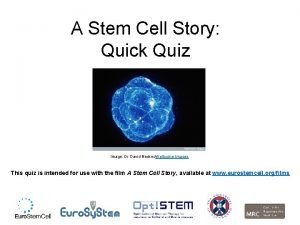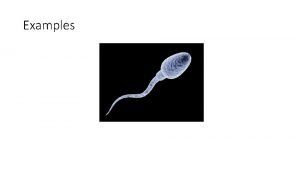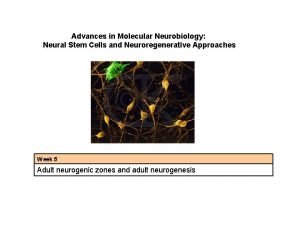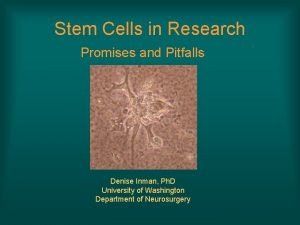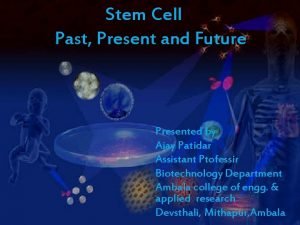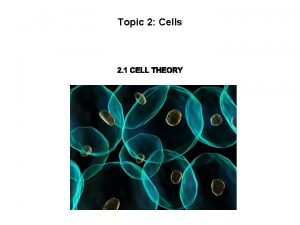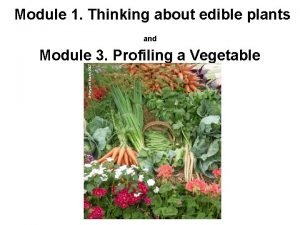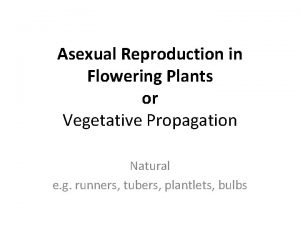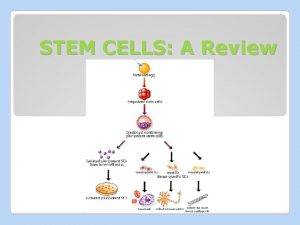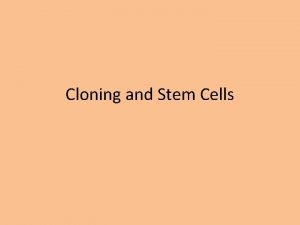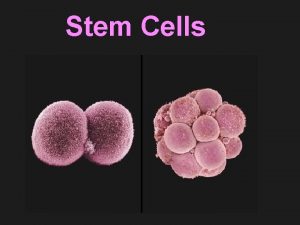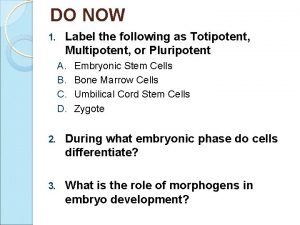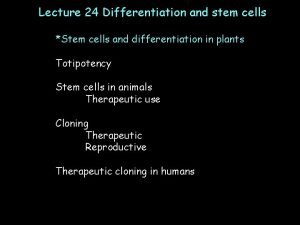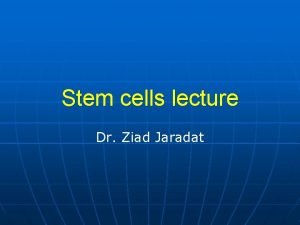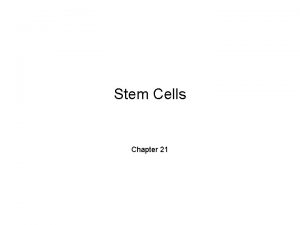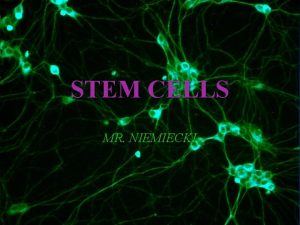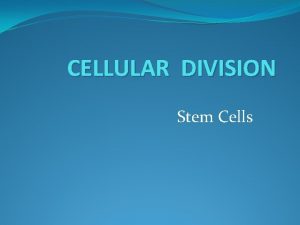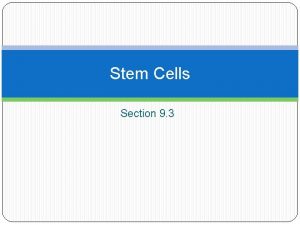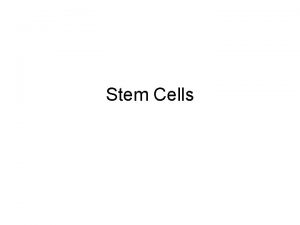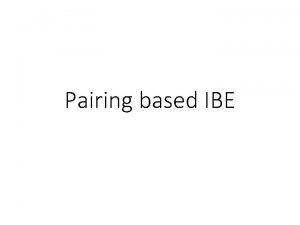Stem Cells Some definitions Totipotent cells can mature

























- Slides: 25

Stem Cells

Some definitions… Totipotent cells can mature into any type of cell. Found in early embryos and plants. Pluripotent cells can form all the cell types in the body (embryonic stem cells). Multipotent cells can form a number of different cell types, e. g. adult stem cells/cord blood stem cells.

Uses of stem cells Medical research Medical treatments e. g. growth of neurones to treat spinal injuries growth of organs for transplants

Reasons For/Against Your turn!

Debate – Should the UK government fund stem cell research? In pairs: - Read the statements on the cards and discuss what that person might think. i. PS = induced pluripotent stem cells (scientists have a method to turn normal adult cells back into stem cells).

What makes a cell change? How do we get from stem cells to fully differentiated, specialised cells?

Controlling development All organisms begin life as a single cell. This cell divides and the new cells produced start to differentiate and specialize. ‘Switching on’ the expression of a gene or keeping it switched off determines the development of features. Many organisms contain similar genes that control development of body plans. For example groups of genes called the homeobox genes play an important role in the development of many multicellular organisms. 7 of 36 © Boardworks Ltd 2009

Homeobox genes The genome of the fruit fly contains one ‘set’ or cluster of homeobox genes. These control development, including the polarity of the embryo, polarity of each segment and the identity of each segment. Homeobox genes code for transcriptional factors. These regulate the expression of other genes important in development. Mutations in homeobox genes can cause changes in the body plan. For example a mutation in the gene controlling leg placement can cause legs to grow where the antennae are normally found. 8 of 36 © Boardworks Ltd 2009

Homeobox genes are present in the genomes of most organisms. They control development of body parts in similar ways. There is little variation in many regions of the homeobox genes in different organisms. This suggests that these have been highly conserved throughout evolutionary history. They are thought to be especially important to the basic development of organisms. 9 of 36 © Boardworks Ltd 2009

How is transcription initiated? In eukaryotic cells, before transcription can begin a gene needs to be stimulated by a regulatory protein, called transcriptional factor. Each transcriptional factor contains sites that can bind to a specific region of the DNA. They cannot initiate transcription alone, but form a pre-initiation complex with RNA polymerase. 10 of 36 © Boardworks Ltd 2009

Function of transcriptional factors Transcriptional factors function in different ways. Some transcriptional factors recognize parts of the promoter sequence at the start of a gene and bind to them. They can either promote or block the functioning of RNA polymerase. inhibitor molecule The action of a transcriptional factor can be switched off by an inhibitor molecule. This can bind to the transcriptional factor, preventing it from attaching to DNA. Without the transcriptional factor the gene cannot be transcribed. 11 of 36 DNA binding site transcriptional factor © Boardworks Ltd 2009

Oestrogen Some hormones, e. g. oestrogen, have an effect on specific cells due to their ability to influence transcriptional factors, and therefore gene expression in the cell. Oestrogen diffuses across the cell membrane. Once inside the cytoplasm it combines with a site on a transcriptional factor. The hormone changes the shape of the transcriptional factor causing the inhibitor molecule to be released. inhibitor molecule DNA binding site transcriptional factor 12 of 36 oestrogen transcription activated © Boardworks Ltd 2009

Small interfering RNA (si. RNA) 13 of 36 © Boardworks Ltd 2009

Small interfering RNA

Petunias Chalcone synthase White pigment Purple pigment

Producing a deep purple petunia Chalcone synthase Purple pigment White pigment Insert gene encoding chalcone synthase More m. RNA synthesised More enzyme produced and more pigment formed

Producing a deep purple petunia Genetically engineered plant White plant ? Deep purple plant Instead of deep purple plants, many of the plants produced were white

Making double-stranded RNA m. RNA is single stranded RNAdependent RNA polymerase A U C C G A G U A C C C A G U A U Uses m. RNA as a template to produce a complementary RNA strand U A G U G C C A U G G G U C A U Two RNA strands held together by hydrogen bonds Doublestranded RNA (ds. RNA) A

What happens to double-stranded RNA? Doublestranded RNA is cut by Dicer enzyme Small interfering RNA (si. RNA) • Usually 21 base pairs long • Two base overhang at each end

Stopping protein synthesis We will start by simplifying the diagram of the si. RNA molecule

Stopping protein synthesis We will start by simplifying the diagram of the si. RNA molecule

Stopping protein synthesis si. RNA forms a complex (RISC) with protein One of the si. RNA strands is destroyed The si. RNA–protein complex binds to m. RNA

Stopping protein synthesis The m. RNA is cut by the si. RNA–protein complex The m. RNA is then broken down. This prevents further protein synthesis

So why were white plants produced instead of deep purple plants? Genetically engineered plant White plant ? Deep purple plant Use the information about making doublestranded RNA and small interfering RNA to explain why.

The genetically engineered petunia plants had a higher concentration of m. RNA This resulted in RNA-dependent RNA polymerase producing double-stranded RNA from this m. RNA More si. RNA molecules were formed that would bind to the m. RNA coding for chalcone synthase Less chalcone synthase was produced so flowers were white, not deep purple
 Totipotent cells
Totipotent cells Sponge
Sponge Leuconoid sponge
Leuconoid sponge Where can scientists obtain stem cells? *
Where can scientists obtain stem cells? * Pluripotent stem cells examples
Pluripotent stem cells examples Stem cells
Stem cells Conclusion of stem cells
Conclusion of stem cells Conclusion of stem cells
Conclusion of stem cells Precursor cells
Precursor cells Branquire
Branquire Which statement best describes embryonic stem cells?
Which statement best describes embryonic stem cells? Outline one therapeutic use of stem cells
Outline one therapeutic use of stem cells Stem cells webquest
Stem cells webquest Stem cells specialization
Stem cells specialization Sometimes you win some sometimes you lose some
Sometimes you win some sometimes you lose some Sometimes you win some sometimes you lose some
Sometimes you win some sometimes you lose some The ice cream is countable or uncountable
The ice cream is countable or uncountable Contact forces
Contact forces Fire and ice diamante poem
Fire and ice diamante poem Some say the world will end in fire some say in ice
Some say the world will end in fire some say in ice Some trust in horses
Some trust in horses Which stem we can eat
Which stem we can eat Vegetative propagation by stem can be seen in
Vegetative propagation by stem can be seen in Waters view
Waters view Transport maximum
Transport maximum Pineal gland
Pineal gland

